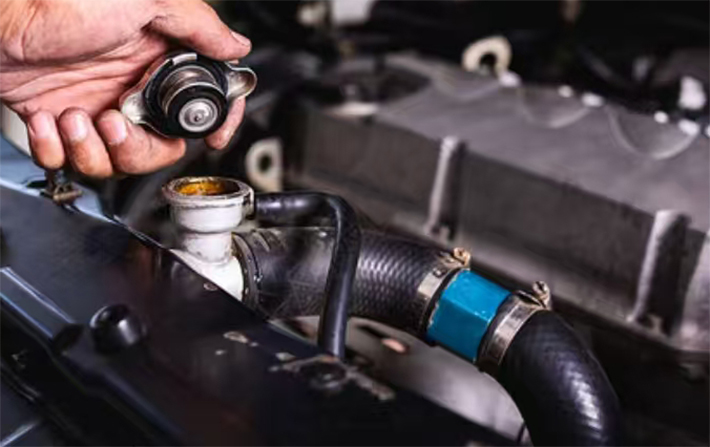What are the problems caused by clogged car radiators?
2025-03-11
The automobile radiator is the core component of the engine cooling system, which undertakes the key task of distributing the heat generated by the engine operation to the air through the coolant circulation. Once the radiator is blocked, the efficiency of the entire cooling system will be greatly reduced, triggering a series of chain reactions that can affect the driving experience and cause serious engine damage. This article will give you a detailed analysis of the five problems that can be caused by radiator blockage:

1.The engine is hot and the power performance is reduced
When the internal channel of the radiator or the external heat sink is blocked by impurities such as sand, rust, and catkins, the circulation speed and heat dissipation efficiency of the coolant will be significantly reduced. The gauge indicator gradually climbs to the red warning zone, at which point the engine may trigger the overheat protection mechanism, forcing a reduction in output power to protect the core components. The owner will obviously feel that the throttle response is slow, the acceleration is weak, and in extreme cases, there will even be a dangerous situation of sudden stalling during driving.
2.Air conditioning refrigeration failure, driving environment deterioration
Modern automobile air conditioning condenser and radiator usually adopt the "front and rear stacked" design structure. When the surface of the radiator is covered with foreign matter, not only its own heat dissipation is blocked, but also the normal heat dissipation of the condenser is blocked. In this case, the pressure at the high pressure end of the air conditioner system increases abnormally, and the compressor may automatically stop working to protect itself. Even if the compressor is barely running, the temperature of the outlet is difficult to reduce, and the driving comfort will be greatly reduced in hot weather.
3.Fuel economy has deteriorated significantly
Experimental data show that for every 10℃ increase in engine operating temperature, fuel consumption will increase by 2%-5%. This is because the high temperature leads to increased carbon accumulation in the combustion chamber, the gasoline atomization effect is worse, and the ECU actively increases the air-fuel ratio to protect the engine. Long-term operation at high temperature may increase vehicle fuel consumption by more than 15%, and the carbon deposit problem will further cause complications such as detonation and cold start difficulties.
4.The interior of the engine is badly damaged
Sustained high temperatures can lead to catastrophic mechanical failure:
- Cylinder pad ablation: High temperature causes the metal cylinder head and the cylinder block to produce asynchronous thermal expansion, leading to the failure of the gasket, and the coolant enters the combustion chamber (white smoke from the exhaust pipe) or the oil emulsification (the oil cap appears milky white foam).
- Piston ring sticking: high temperature causes the oil film to break, piston ring and cylinder wall direct friction, light pull cylinder, heavy lead to piston welding.
- Electronic system failure: In high temperature environments, the working life of precision electronic components such as oxygen sensors and knock sensors will be greatly shortened.
5.Winter heating system failure
In the cold season, the heat of the warm air system actually comes from the engine coolant. If the blockage of the radiator leads to poor coolant circulation, the amount of heat exchange flowing through the warm air tank will be reduced, and even if the temperature is adjusted to the highest, the outlet air temperature is still difficult to increase. This situation is especially dangerous in the northern cold region, and the failure of the front windshield fog removal function will directly affect driving safety.
Prevention and maintenance suggestions
1.Regular cleaning of the radiator: professional disassembly and washing every 2 years or 40,000 kilometers, and timely cleaning of foreign bodies such as catkins and mosquitoes attached to the surface of the radiator in spring.
2.Selection of qualified coolant: Avoid the use of tap water, choose a regular coolant with anti-rust, anti-boiling, anti-freeze function, and maintain a reasonable mixing ratio.
3.Daily inspection: Check the coolant level every month, and find abnormal consumption (such as falling more than 1/3 of the scale line within two weeks) need to be repaired immediately.
4.Install protective devices: Install anti-bug nets in front of the radiator, and check the operating status of the cooling fan regularly.
Summary
The radiator is like the "respiratory system" of the car, and its smooth or not is directly related to the health status of the vehicle. Through regular maintenance, timely discovery and solution of congestion problems, not only to avoid tens of thousands of yuan of engine overhaul costs, but also to ensure driving safety and driving comfort. When the initial signs such as abnormal water temperature and weakening of air conditioning cooling are found, it is recommended to go to a professional maintenance institution for system testing as soon as possible.